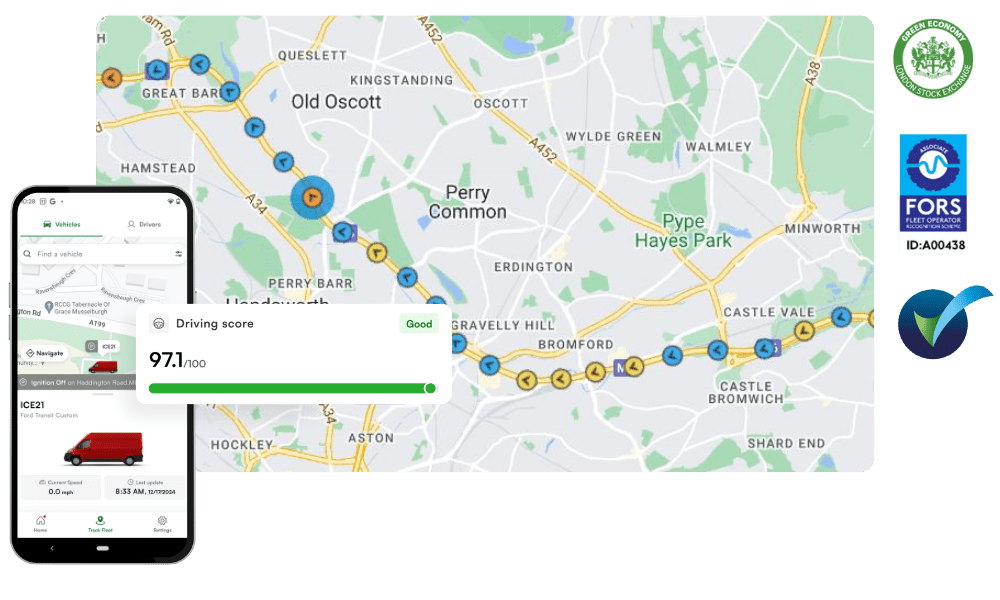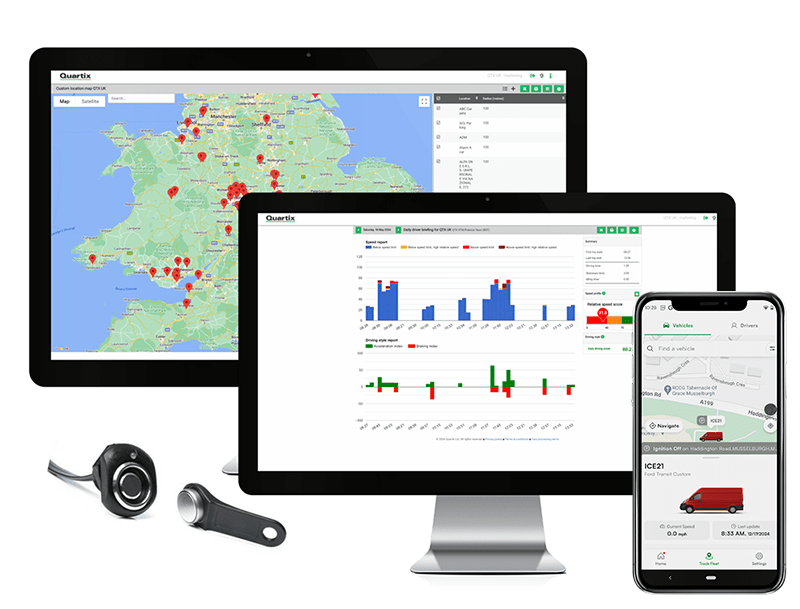Road fatalities increased last year
According to provisional data from the Department for Transport, there were an estimated 1,633 UK road fatalities in 2024, representing a 1% increase compared to 2023. One often overlooked factor is the role of employers – businesses have both a duty and an opportunity to reduce these risks.
One third of collisions involve someone driving for work
Research indicates that up to a third of all road traffic collisions in the UK involve someone who is driving for work purposes, which may account for over 20 fatalities and 150 serious injuries every week.
While employers are required to manage health and safety risks for workers driving as part of their job, incidents occurring on public roads are generally not reportable under the Reporting of Injuries, Diseases and Dangerous Occurrences Regulations (RIDDOR) to the Health and Safety Executive. This can lead to underreporting of work-related road incidents – highlighting the importance of employers proactively managing road safety for their employees.
A record number of vehicles fail MOTs due to tyre defects
Data from the DVSA confirms that 2,152,849 vehicles failed their MOT due to tyre defects in the 2023–2024 period, marking a record high. The number of tyre-related MOT failures increased from 1.83 million in 2019–2020 to over 2.15 million in 2023–2024, a rise of 17%.
Additionally, more than 750,000 of these vehicles had previously been issued tyre-related advisories, indicating a pattern of neglected maintenance.
1 in 5 people forget to check tyres
A survey conducted by the RAC found that 5% of drivers never check their tyres, and 20% do so only when they remember, not regularly. If you have company vehicles, regular vehicle checks should form part of your driving for work policy.
See our guide to help educate your staff on the dangers of poor tyre health and check out the Quartix Check vehicle inspections app to help you manage regular vehicle safety checks.
3 points for every defective tyre
Driving with defective or illegal tyres can result in significant penalties:
- Fine: Up to £2,500 per illegal tyre.
- Penalty Points: 3 points per defective tyre.
Accumulating 12 or more penalty points within a three-year period can lead to disqualification from driving. Ensure compliance with tyre regulations and maintain road safety, by regularly checking tyre tread depth, pressure, and overall condition.

The significant number of tyre-related MOT failures and the neglect of tyre advisories underscore the need for increased awareness and regular vehicle maintenance to improve road safety. TyreSafe is urging police officers to check tyre condition during any vehicle stops as a way to remind drivers of their duty to maintain roadworthy tyres. The message is clear: you could be stopped at any time, and unsafe tyres carry serious penalties. They aim to reduce tyre-related collisions by increasing awareness and encouraging regular tyre checks.
An employers’ duty to ensure safe driving
Under the Health and Safety at Work Act 1974, employers are legally required to ensure the health, safety, and welfare of all employees, including those who drive as part of their work duties. This encompasses conducting risk assessments related to driving activities, ensuring vehicles are roadworthy, and that drivers are competent and fit for driving tasks.
A written Health and Safety Policy is a requirement
If a business employs five or more individuals, it is legally required to have a written health and safety policy. This policy should outline the company’s approach to managing health and safety, including procedures related to driving for work. It’s best practice to include driving for work within the overall health and safety policy or as a separate document. This ensures that risks associated with driving are adequately managed and that employees are aware of the company’s expectations and procedures related to driving tasks.
The importance of a Driving for Work Policy
Implementing a comprehensive driving for work policy is crucial for managing occupational road risks. Such a policy helps in:
- Reducing the likelihood of road incidents involving employees.
- Ensuring compliance with legal obligations.
- Protecting the company from potential liabilities.
- Promoting a culture of safety within the organisation.
Having a clear and documented driving policy is a proactive step towards safeguarding both employees and the organisation.
“Road safety is not just about driving behaviour. Fatigue, stress, medical impairment all impact someone’s ability to drive safely. So employers must consider the pressures that their staff might be under and assess these factors, as well as vehicle safety and other measures.
Setting clear standards, monitoring behaviour, reporting collisions, and using tools like telematics to identify risk are all crucial steps. With the right interventions in place, businesses can protect their drivers and the public, and create a culture of safety.”
Anne-Marie Penny, Senior Road Safety Policy Adviser, National Highways
Is speeding a key risk?
With hundreds of thousands of tracked vehicles on the roads daily, we offer a unique view of driving behaviour. Analysis of over 663 million data points from our SafeSpeed database reveals UK speeding hotspots, with the M6 Toll (between Tamworth and Burntwood) topping the list, where 46% of drivers exceed the 70mph limit. Similar trends appear on the M61 near the Horwich Interchange.
Our driver monitoring tools highlight risky behaviours like speeding and harsh braking, helping businesses identify high-risk drivers and take action. Driver scores and league tables can provide incentives and guidance to reduce collisions, improve fuel efficiency, and cut maintenance costs – one customer saw a 65% drop in accidents and £150,000 in maintenance savings in just one year.
With our SafeSpeed scoring system, drivers are also benchmarked against average speeds driven on the same road segments – especially useful on rural roads, where driving at the posted limit isn’t always safe.
Mark Cartwright, Head of Commercial Vehicle Incident Prevention at National Highways, highlighted the critical role of proactive safety management for mobile teams in an episode of our Fleet Insider podcast.
“I think the kind of rich data that businesses can pull from systems such as Quartix is invaluable. I’ve always liked Quartix’s SafeSpeed feature. We know that speed is a significant cause of collisions and certainly makes them more serious” says Mark.
Reducing driver distraction
Dr. Martin Langham’s paper “Crikey! It’s Cognitively Complex” explores how mental overload and distraction impact driver performance. Langham highlights that driving is a cognitively demanding task, and errors like “looked but failed to see” often stem from cognitive limitations, not carelessness.
Understanding these cognitive limitations is crucial for designing interventions, policies, and training programs aimed at reducing road accidents caused by driver distraction and mental overload.
This is why Quartix chooses not to include in-cab, audible driver feedback with our vehicle trackers – we believe it’s safer to provide that feedback when the driver is no longer behind the wheel. When we are driving, there are already plenty of distractions.
Instead, drivers can access their scores, trends, and daily logs through the mobile app, allowing them to review performance safely. Managers can use this data to identify and support drivers showing potential risk, without introducing additional distractions or safety concerns.

Learn More from UKROED
We’d like to thank James Luckhurst of UKROED for his continued contributions to road safety and for having Quartix as a guest in his recent webinar series. If you’re looking to deepen your understanding of driver behaviour, risk mitigation, and education-based enforcement, we highly recommend exploring the UKROED webinar resources curated by James.
Start managing road safety today
Want to take the guesswork out of managing road risk? Speak to us about how Quartix can help you protect your drivers, reduce costs, and stay compliant.
Book your demo today and learn about the full suite of Quartix fleet tracking tools.
- GPS tracking and vehicle activity logs
- Driver behaviour monitoring
- Safe speed reports
- Vehicle safety inspections
- ‘Fit to drive’ assessments
- Incident reporting and crash data
- Forward-, rear- and driver-facing connected dashcams
- MOT and service date reminders


